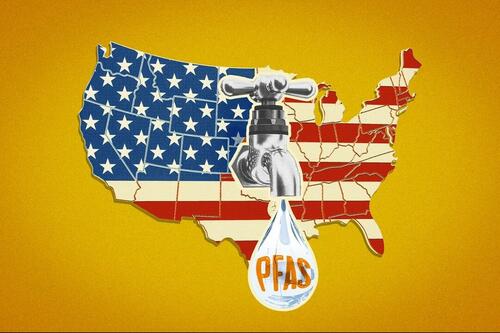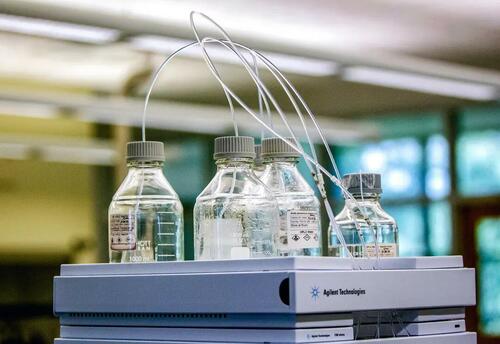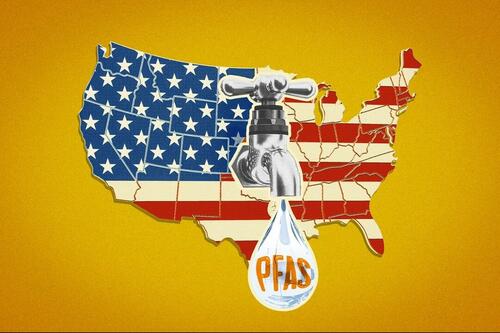‘Forever Chemicals’ In US Drinking Water: A Growing Problem
Authored by Autumn Spredemann via The Epoch Times (emphasis ours),
Formally identified as perfluoroalkyl and polyfluoroalkyl substances, a group of manmade chemicals known as PFAS are found in everything from soil and food to common household items and water. An overabundance of these compounds has been detected in U.S. drinking water and that of other industrialized nations, sparking discussion on control and mitigation among experts.

Exposure to PFAS has been linked to serious chronic health issues such as increased risk of certain cancers, fertility problems, and immune system challenges.
Unlike some industrial chemicals, PFAS don’t break down and are difficult to destroy, thus earning the moniker “forever chemicals.”
Since the 1940s, PFAS compounds have been used in everyday items such as nonstick cookware, water-repellent clothes, stain-resistant fabrics, cosmetics, and firefighting foams, according to the Agency for Toxic Substances and Disease Registry.
Able to resist water, grease, oil, and heat, PFAS compounds quickly became popular. More than half a century later, these forever chemicals have become a growing health and environmental concern.
This year, the U.S. Environmental Protection Agency (EPA) said it has observed forever chemicals in America’s groundwater at alarming levels, prompting the first-ever national, enforceable standard for drinking water, meant to protect communities from dangerous amounts of PFAS exposure.
“I believe this is a serious public health concern. From what I’ve seen in my work, chemical exposure—even at low levels—can affect communities long-term. And PFAS isn’t something that just disappears,” Previn Pillay, CEO of Pyromin Consulting, told The Epoch Times by email.
Pillay has dealt with complex water contamination issues including waste treatment and government compliance. He said forever chemicals can build up in people and the environment over time, causing a domino effect of negative consequences.

“Studies suggest that PFAS exposure can increase the risk of metabolic diseases, which is already becoming a growing issue in affected areas. I’ve seen how industrial contaminants, when not controlled, can cause health problems down the line. It’s something we just can’t ignore,” Pillay said.
Probable links between consumption of forever chemicals and negative health outcomes have been studied for years and the results paint a grim picture.
“First, the structure of PFAS means they resist breakdown in the environment and in our bodies. Second, they move relatively quickly through the environment, making their contamination hard to contain. Third, for some PFAS, even extremely low levels of exposure can negatively impact our health,” the senior strategic director of health and food for the Natural Resources Defense Council, Erik D. Olson, said in April.
On its website, the EPA states its new regulations are meant to “reduce PFAS exposure for approximately 100 million people, prevent thousands of deaths, and reduce tens of thousands of serious illnesses. EPA concurrently announced a further $1 billion to help states and territories implement PFAS testing and treatment at public water systems and to help owners of private wells address PFAS contamination.”
EPA data show it has detected PFAS in 7,237 U.S. public water systems.
Among the contaminants observed is lithium, a subclass of the forever chemicals group that’s a growing concern, according to the Pratt School of Engineering.
The National Institute of Environmental Health Science states that nearly 15,000 synthetic substances fall into the forever chemicals category.
This year, at hundreds of drinking water sites across the country, the nonprofit Environmental Working Group reported PFAS levels higher than the EPA’s proposed limits of 4 and 10 parts per trillion. Coastal states have the highest concentrations of above-regulation forever chemical contamination.
In October, the U.S. Government Accountability Office said PFAS may be America’s “biggest water problem since lead.”

Life Cycle Consideration
“As someone deeply embedded in the water filtration business for decades, I can affirm that the presence of PFAS in drinking water is a pressing public health concern,” Brian McCowin told The Epoch Times.
McCowin is the service manager at McCowin Water, the business his father started.
“To manage PFAS better, collaboration between private sectors like ours and regulatory bodies is key,” McCowin said.
“We’ve successfully steered complex water issues by prioritizing ethical practices and transparency with clients. This approach could inspire improved standards and accountability across the board.”
Pillay also thinks cooperation is the fastest way to mitigate PFAS in American water.
“I think partnerships between private companies and government bodies can speed up solutions. Public-private partnerships would bring together the resources and expertise needed to drive faster water treatment innovations,” he said.
“If we’re going to manage this PFAS contamination better, we need both sectors working together, sharing knowledge, and accelerating the development of advanced filtration systems.”
Although filtration has always been the go-to solution for removing PFAS in water, some researchers believe the scope of the contamination requires a new approach.
An environmental engineering team at the University of California, Riverside (UCR) published a study in July that discovered a special bacteria that can destroy certain types of forever chemicals. The microbes are already prevalent in wastewater.
In their observations, researchers noted the bacteria attack the previously impenetrable carbon-fluorine bond in PFAS compounds. This is a critical step towards removing the “forever” part of the chemicals.
Read the rest here…
Tyler Durden
Tue, 11/12/2024 – 05:00


Recent Comments